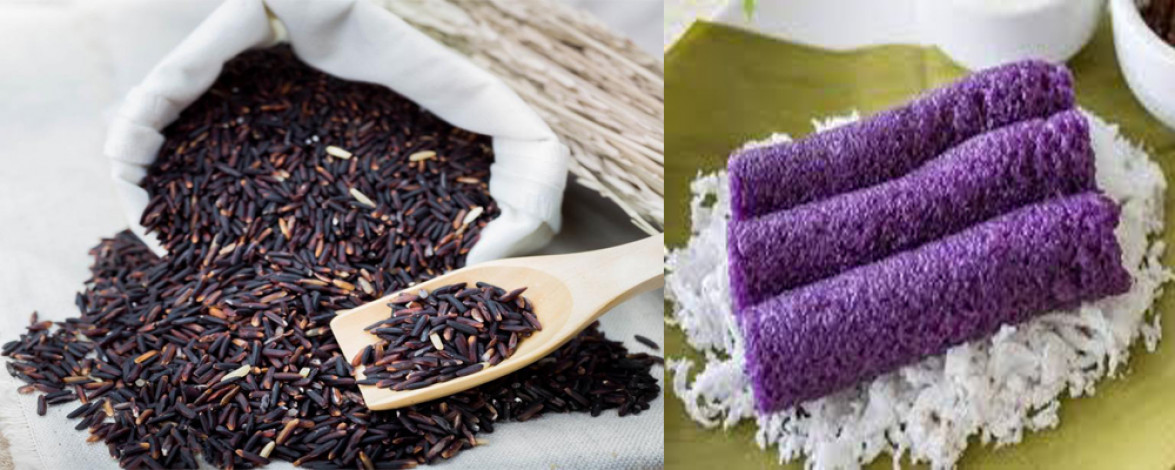
File Photo
The health benefits of purple rice have received a lot of
media attention, although this colorful food staple is not new. The ancient
Chinese revered it so much that only the emperor was allowed to eat it.
Purple rice has a deep black color, but it turns purple when
people cook it. Sometimes, people call it black rice. It is mainly grown in
Asia and is slightly chewy with a nutty flavor.
It is one of more than 40,000 varieties of cultivated rice.
While the nutritional values vary, all varieties of rice are a good source of
carbohydrate, have almost no fat or cholesterol, and provide some protein.
Purple rice has a similar number of calories to white or
brown rice, but it contains more protein, iron, and antioxidants.
Protein
All cells and tissues in the body contain protein, which
plays a role in a wide range of metabolic interactions. It is essential for
growth and body repair and for maintaining good health.
The Dietary Guidelines for Americans 2015–2020Trusted Source
recommend that protein should make up 10–35% of an adult’s diet.
A 100 gram Trusted Source (g) serving of dry medium grain
purple rice contains about 8.89 g of protein.
Fiber
Dietary fiber offers many health benefits, such as aiding
weight loss and helping reduce the risk of heart disease and diabetes.
It is also important for digestive health as it can help
prevent constipation and may also protect against colorectal cancer.
A 100 g serving of dry purple rice contains about 2.2 g Trusted
Source of fiber. The Dietary Guidelines recommend consuming up to 33.6 g Trusted
Source a day of fiber, depending on the person’s age and sex.
Iron
People need iron to make red blood cells, which carry oxygen
around the body. Low iron intake can lead to iron deficiency anemia.
People should consume up to 18 milligrams Trusted Source
(mg) of iron a day, depending on their age and sex. During pregnancy and around
the time of menstruation, a woman may need to increase her intake of iron.
A 100 g serving of dry purple rice contains 2.4 mg Trusted Source of iron.
Purple rice may have
several health benefits:
Heart health and
cholesterol
According to a study in the Journal of Agriculture and Food
Chemistry, purple rice contains more antioxidant compounds than white rice.
There is evidence Trusted Source that antioxidants can
promote heart health and lower the risk of some cancers. These compounds help
eliminate harmful free radicals.
The body produces free radicals naturally, but if too many
build up, oxidative stress can occur. Oxidative stress increases the risk of
many health problems, including heart disease.
The authors of a 2016 study Trusted Source noted previous
animal research in which purple rice reduced the levels of “bad” low density
lipoprotein (LDL) cholesterol in the body and increased the levels of “good”
high density lipoprotein (HDL) cholesterol.
A healthy cholesterol balance is vital for a healthy
cardiovascular system. Doctors believe that it helps decrease the
atherosclerotic plaque formation in the arteries that can lead to heart
failure. It may do this due to its dietary fiber content, which has benefits Trusted
Source for heart health.
Digestion
As a rich source of dietary fiber, purple rice can help keep
the digestive system working properly, preventing constipation and other
digestive problems.
Liver function
Oxidative stress can lead to Trusted Source liver damage.
Foods that contain antioxidants help reduce oxidative stress. The antioxidants
in purple rice may, therefore, help keep the liver healthy.
The cholesterol lowering activity of purple rice may also benefit
the liver. A 2012 study Trusted Source found that mice that ate a high fat diet
with a purple rice extract had reduced markers of liver disease compared with
those that did not consume the extract.
How to cook purple
rice
Share on Pinterest Compared to white or brown rice, purple
rice contains more fiber and protein.
People can follow the steps below to cook purple rice:
1. Rinse the
rice three or four times in cool water.
2. Add 2
cups of water to each cup of rice in a pan.
3. Bring the
water to a gentle boil with a tablespoon of olive oil or butter and a pinch of
salt. Alternatively, use stock or coconut water to add flavor.
4. Cover the
pot and reduce the heat to let it simmer for about 20 minutes or until the rice
has absorbed all of the liquid.
5. Remove
the pot from the heat and let it stand for 5 minutes with the lid on.
To make softer rice, use an extra quarter of a cup of water
and cook it over a low flame for a further 10 minutes.
Purple, or black, rice is a variety of rice with a long
history. Its nutritional profile is similar to that of brown rice, as it is
relatively high in fiber.
Its fiber content makes it more nutritious than many
varieties of white rice.
Comment Now